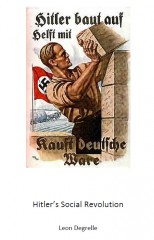
Author : Degrelle Léon
Title : Hitler's social revolution
Year : 19**
Link download : Degrelle_Leon_-_Hitler_s_social_revolution.zip
One of the first labor reforms to benefit the German workers was the establishment of annual paid vacation. The Socialist French Popular Front, in 1936, would make a show of having invented the concept of paid vacation, and stingily at that, only one week per year. But Adolf Hitler originated the idea, and two or three times as generously, from the first month of his coming to power in 1933. Every factory employee from then on would have the legal right to a paid vacation. Until then, in Germany paid holidays where they applied at all did not exceed four or five days, and nearly half the younger workers had no leave entitlement at all. Hitler, on the other hand, favored the younger workers. Vacations were not handed out blindly, and the youngest workers were granted time off more generously. It was a humane action; a young person has more need of rest and fresh air for the development of his strength and vigor just coming into maturity. Basic vacation time was twelve days, and then from age 25 on it went up to 18 days. After ten years with the company, workers got 21 days, three times what the French socialists would grant the workers of their country in 1936. These figures may have been surpassed in the more than half a century since then, but in 1933 they far exceeded European norms. As for overtime hours, they no longer were paid, as they were everywhere else in Europe at that time, at just the regular hourly rate. The work day itself had been reduced to a tolerable norm of eight hours, since the forty-hour week as well, in Europe, was first initiated by Hitler. And beyond that legal limit, each additional hour had to be paid at a considerably increased rate. As another innovation, work breaks were made longer; two hours every day in order to let the worker relax and to make use of the playing fields that the large industries were required to provide. Dismissal of an employee was no longer left as before the sole discretion of the employer. In that era, workers’ rights to job security were non-existent. Hitler saw to it that those rights were strictly spelled out. The employer had to announce any dismissal four weeks in advance. The employee then had a period of up to two months in which to lodge a protest. The dismissal could also be annulled by the Honor of Work Tribunal. What was the Honor of Work Tribunal? Also called the Tribunal of Social Honor, it was the third of the three great elements or layers of protection and defense that were to the benefit of every German worker. The first was the Council of Trust. The second was the Labor Commission. The Council of Trust was charged with attending to the establishment and the development of a real community spirit between management and labor. “In any business enterprise,” the Reich law stated, “the employer and head of the enterprise, the employees and workers, personnel of the enterprise, shall work jointly towards the goal of the enterprise and the common good of the nation.” Neither would any longer be the victim of the other—not the worker facing the arbitrariness of the employer nor the employer facing the blackmail of strikes for political purposes. Article 35 of the Reich labor law stated that: “Every member of an Aryan enterprise community shall assume the responsibilities required by his position in the said common enterprise.” In other words, at the head of the company or the enterprise would be a living, breathing executive in charge, not a moneybags with unconditional power. “The interest of the community may require that an incapable or unworthy employer be relieved of his duties.” The employer would no longer be inaccessible and all-powerful, authoritatively determining the conditions of hiring and firing his staff. He, too, would be subject to the workshop regulations, which he would have to respect, exactly as the least of his employees. The law conferred honor and responsibility on the employer only insofar as he merited it. Every business enterprise of 20 or more persons was to have its “Council of Trust.” The two to ten members of this council would be chosen from among the staff by the head of the enterprise. The ordinance of application of 10 March 1934 of the above law further stated: “The staff shall be called upon to decide for or against the established list in a secret vote, and all salaried employees, including apprentices of 21 years of age or older, will take part in the vote. Voting shall be done by putting a number before the names of the candidates in order of preference, or by striking out certain names.” In contrast to the business councils of the preceding régime, the Council of Trust was no longer an instrument of class, but one of teamwork of the classes, composed of delegates of the staff as well as the head of the enterprise. The one could no longer act without the other. Compelled to coordinate their interests, though formerly rivals, they would now cooperate to establish by mutual consent the regulations which were to determine working conditions. Belgian author Marcel Laloire, who observed conditions in the Reich first hand, wrote “The Council has the duty to develop mutual trust within the enterprise. It will advise on all measures serving to improve the carrying out of the work of the enterprise and on standards relating to general work conditions, in particular those which concern measures tending to reinforce feelings of solidarity between the members themselves and between the members and the enterprise, or tending to improve the personal situation of the members of the enterprise community. The Council also has the obligation to intervene to settle disputes. It must be heard before the imposition of fines based on workshop regulations.” Before assuming their duties, members of the Work Council had to take an oath before all their co-workers to “carry out their duties only for the good of the enterprise and of all citizens, setting aside any personal interest, and in their behavior and manner of living to serve as model representatives of the enterprise.” (Article 10, paragraph 1 of the law.) Every 30th of April, on the eve of the great national labor holiday, council duties ceased and the councils were renewed, pruning out conservatism or petrifaction and cutting short the arrogance of dignitaries who might have thought themselves beyond criticism. It was up to the enterprise itself to pay a salary to members of the Council of Trust, just as if they were employed in the work area, and “to assume all costs resulting from the regular fulfillment of the duties of the Council.” The second agency that would ensure the orderly development of the new German social system was the institution of the “Workers’ Commissioners.” They would essentially be conciliators and arbitrators. When gears were grinding, they were the ones who would have to apply the grease. They would see to it that the Councils of trust were functioning harmoniously to ensure that regulations of a given business enterprise were being carried out to the letter. They were divided among 13 large districts covering the territory of the Reich. As arbitrators they were not dependent upon either owners or workers. They had total independence in the field. They were appointed by the state, which represented both the interests of everyone in the enterprise and the interests of society at large. In order that their decisions should never be unfounded or arbitrary, they had to rely on the advice of a “Consulting Council of Experts” which consisted of 18 members selected from various sections of the economy in a representation of sorts of the interests of each territorial district. To ensure still further the objectivity of their arbitration decisions, a third agency was superimposed on the Councils of Trust and the 13 Commissioners, the Tribunal of Social Honor. Thus from 1933 on, the German worker had a system of justice at his disposal that was created especially for him and would adjudicate all grave infractions of the social duties based on the idea of the Aryan enterprise community. Examples of these violations of social honor are cases where the employer, abusing his power, displayed ill will towards his staff or impugned the honor of his subordinates, cases where staff members threatened work harmony by spiteful agitation; the publication by members of the Council of confidential information regarding the enterprise which they became cognizant of in the course of discharging their duties. Thirteen “Tribunes of Social Honor” were established, corresponding with the thirteen commissions. The presiding judge was not a fanatic; he was a career judge who rose above disputes. Meanwhile the enterprise involved was not left out of the proceedings; the judge was seconded by two assistant judges, one representing the management, another a member of the Council of Trust. This tribunal, the same as any other court of law, had the means of enforcing its decisions. But there were nuances. Decisions could be limited in mild cases to a remonstrance. They could also hit the guilty party with fines of up to 10,000 marks. Other very special sanctions were provided for that were precisely adapted to the social circumstances; change of employment, dismissal of the head of the enterprise or his agent who had failed in his duty. In case of a contested decision, the legal dispute could always be taken up to a Supreme Court seated in Berlin—a fourth level of protection. From then on the worker knew that exploitation of his physical strength in bad faith or offending his honor would no longer be allowed. He had to fulfill certain obligations to the community, but they were obligations that applied to all members of the enterprise, from the chief executive down to the messenger boy. Germany’s workers at last had clearly established social rights that were arbitrated by a Labor Commission and enforced by a Tribunal of Honor. Although effected in an atmosphere of justice and moderation, it was a revolution. This was only the end of 1933, and already the first effects could be felt. The factories and shops large and small were reformed or transformed in conformity with the strictest standards of cleanliness and hygiene; the interior areas, so often dilapidated, opened to light; playing fields constructed; rest areas made available where one could converse at one’s ease and relax during rest periods; employee cafeterias; proper dressing rooms. With time, that is to say in three years, those achievements would take on dimensions never before imagined; more than 2,000 factories refitted and beautified; 23,000 work premises modernized; 800 buildings designed exclusively for meetings; 1,200 playing fields; 13,000 sanitary facilities with running water; 17,000 cafeterias. Eight hundred departmental inspectors and 17,300 local inspectors would foster and closely and continuously supervise these renovations and installations. The large industrial establishments moreover had been given the obligation of preparing areas not only suitable for sports activities of all minds, but provided with swimming pools as well. Germany had come a long way from the sinks for washing one’s face and the dead tired workers, grown old before their time, crammed into squalid courtyards during work breaks. In order to ensure the natural development of the working class, physical education courses were instituted for the younger workers; 8,000 such were organized. Technical training would be equally emphasized, with the creation of hundreds of work schools, technical courses and examinations of professional competence, and competitive examinations for the best workers for which large prizes were awarded. To rejuvenate young and old alike, Hitler ordered that a gigantic vacation organization for workers be set up. Hundreds of thousands of workers would be able every summer to relax on and at the sea. Magnificent cruise ships would be built. Special trains would carry vacationers to the mountains and to the seashore. The locomotives that hauled the innumerable worker-tourists in just a few years of travel in Germany would log a distance equivalent to fifty-four times around the world! The cost of these popular excursions was nearly insignificant, thanks to greatly reduced rates authorized by the Reichsbank. Didn’t these reforms lack something? Were some of them flawed by errors and blunders? It is possible. But what did a blunder amount to alongside the immense gains? That this transformation of the working class smacked of authoritarianism? That’s exactly right. But the German people were sick and tired of socialism and anarchy. To feel commanded didn’t bother them a bit. In fact, people have always liked having a strong man guide them. One thing for certain is that the turn of mind of the working class, which was still almost two-thirds non-National Socialist in 1933, had completely changed. The Belgian author Marcel Laloire would note: “When you make your way through the cities of Germany and go into the working-class districts, go through the factories, the construction yards, you are astonished to find so many workers on the job sporting the Hitler insignia, to see so many flags with the Swastika, black on a bright red background, in the most populous districts.” The “Labor Front” that Hitler imposed on all of the workers and employers of the Reich was for the most part received with favor. And already the steel spades of the sturdy young lads of the National Labor Service could be seen gleaming along the highways. The National Labor Service had been created by Hitler out of thin air to bring together for a few months in absolute equality, and in the same uniform, both the sons of millionaires and the sons of the poorest families. All had to perform the same work and were subject to the same discipline, even the same pleasures and the same physical and moral development. On the same construction sites and in the same living quarters, they had become conscious of their commonality, had come to understand one another, and had swept away their old prejudices of class and caste. After this hitch in the National Labor Service they all began to live as comrades, the workers knowing that the rich man’s son was not a monster, and the young lad from the wealthy family knowing that the worker’s son had honor just like any other young fellow who had been more generously favored by birth. Social hatred was disappearing, and a socially united people was being born. Hitler could already go into factories—something no man of the so-called Right before him would have risked doing—and hold forth to the mob of workers, tens of thousands of them at a time, as in the Siemens works. “In contrast to the von Papens and other country gentlemen,” he might tell them, “In my youth I was a worker like you. And in my heart of hearts, I have remained what I was then.” In the course of his twelve years in power, no incident ever occurred at any factory Adolf Hitler ever visited. When Hitler was among the people, he was at home, and he was received like the member of the family who had been most successful. ...

Gaidoz Henri - Etudes de mythologie gauloise
Auteur : Gaidoz Henri Ouvrage : Etudes de mythologie gauloise Année : 1886 Lien de téléchargement :...














